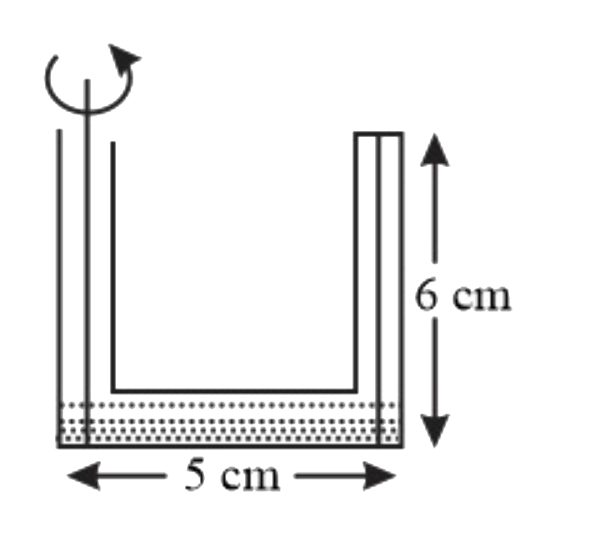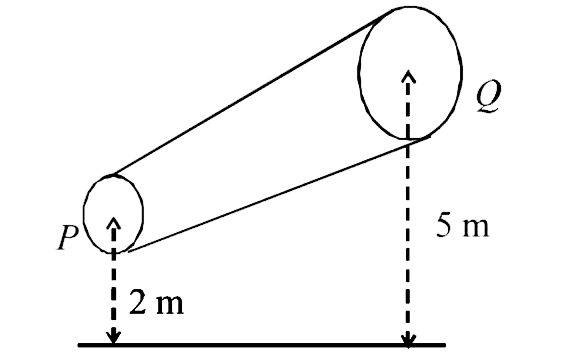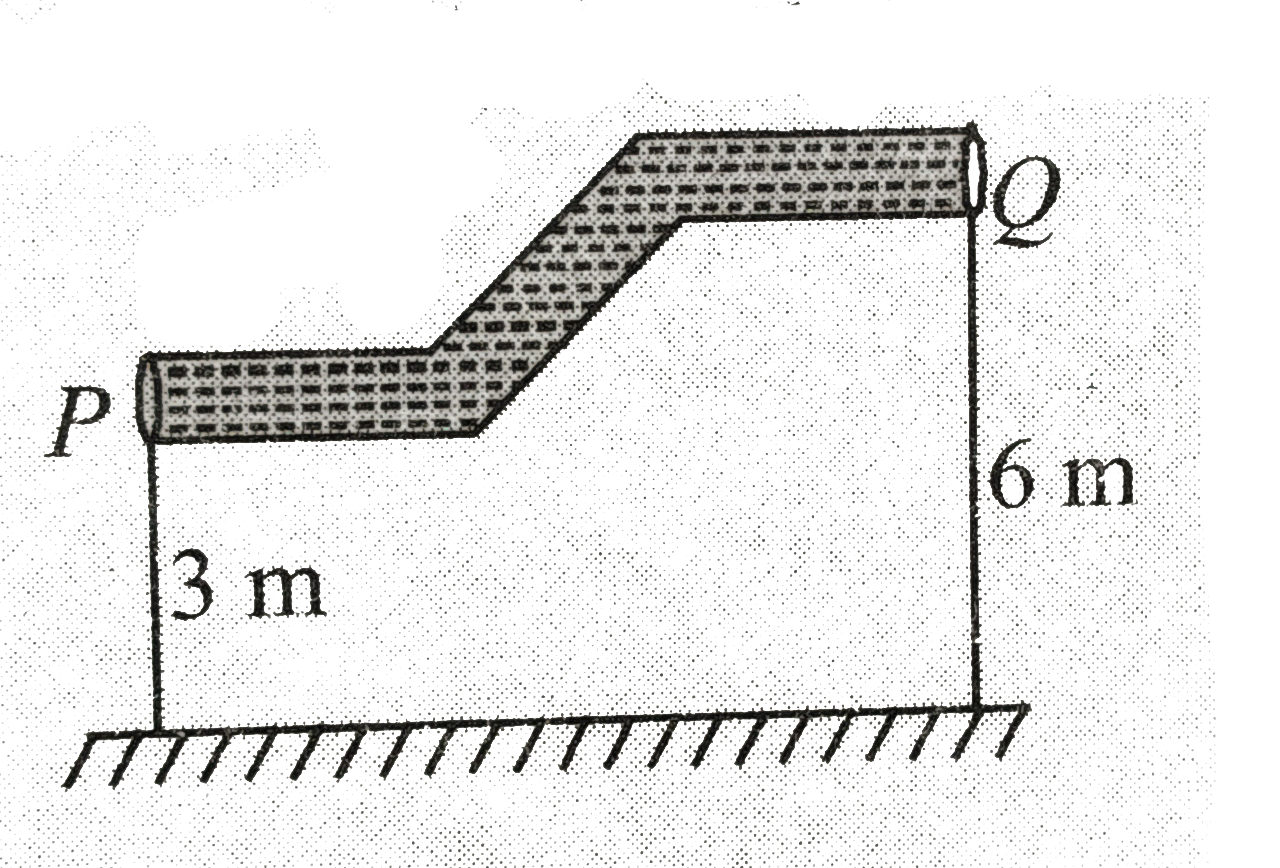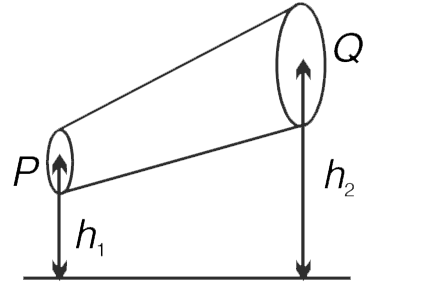A non-viscous liquid of constant density 1000kg/m3 flows in a streamline notion along a tube of variable cross-section. The tube is kept inclined in the vertical plane as shown in the figure. The area of cross-section of the tube at two points P and Q at heights of 2m and 5m are respectively 4×103m2 and 8×10−3m2. The velocity of the liquid at point P is 1m/s. Find the work done per unit volume by the pressure and the gravity forces as the fluid flows from point P to Q. Take g=9.8m/s2.

The correct Answer is:+29625J/m3,−30000J/m3
Step by step video & image solution for A non-viscous liquid of constant density 1000 kg//m^(3) flows in a streamline notion along a tube of variable cross-section. The tube is kept inclined in the vertical plane as shown in the figure. The area of cross-section of the tube at two points P and Q at heights of 2m and 5m are respectively 4xx10^(3)m^(2) and 8xx10^(-3)m^(2). The velocity of the liquid at point P is 1m//s. Find the work done per unit volume by the pressure and the gravity forces as the fluid flows from point P to Q. Take g=9.8m//s^(2). by Physics experts to help you in doubts & scoring excellent marks in Class 11 exams.
Updated on:21/07/2023Topper's Solved these Questions
- ELASTICITY, SURFACE TENSION AND FLUID MECHANICSBOOK - ALLENCHAPTER - ELASTICITY, SURFACE TENSION AND FLUID MECHANICSEXERCISE - Exercise 4 A (Viscosity)
3 Videos
- ELASTICITY, SURFACE TENSION AND FLUID MECHANICSBOOK - ALLENCHAPTER - ELASTICITY, SURFACE TENSION AND FLUID MECHANICSEXERCISE - Exercise 4 B (Bran storming Subjective Exercise)
15 Videos
- ELASTICITY, SURFACE TENSION AND FLUID MECHANICSBOOK - ALLENCHAPTER - ELASTICITY, SURFACE TENSION AND FLUID MECHANICSEXERCISE - Exercise 4 A (Fluid Statics)
13 Videos
- CENTRE OF MASSBOOK - ALLENCHAPTER - CENTRE OF MASSEXERCISE - EXERCISE-V B
19 Videos
- ERROR AND MEASUREMENTBOOK - ALLENCHAPTER - ERROR AND MEASUREMENTEXERCISE - Part-2(Exercise-2)(B)
22 Videos
Similar Questions
A flask contains glycerine and the other contains water. Both are stirred vigorously and placed on the table. In which flask will the liquid come to rest earlier and why?
View SolutionLength of the horizontal arm of a uniform cross - section U - tube is l = 5 cm and both ends of the vertical arms are open to the surrounding pressure of 7700 N m−2. A liquid of density ρ=103 kg m−3 is poured into the tube such that the liquid just fills the horizontal part of the tube. Now, one of the open ends is sealed and the tube. Now, one of the open ends is sealed and the tube is then rotaed about a vertical axis passing through the other veritcal arm with angular velocity ω due to which the liquid rises up to half the length of the vertical arm. If length of each vertical arm is a = 6 cm. What is the value of ω(in rad s−1)?

View SolutionA hydraulic automobile lift is designed to lift cars with a maximum mass of 3000Kg. The area of cross section of the piston carrying the load is 425cm2. What maximum pressures would the smaller piston have to bear?
View SolutionTwo particles of mases m1 and m2 in projectile motion have velocitie →v1 and →v2, respectively at time t=0. they collide at time t0. Their velocities become →v′1 and →v′2 at time 2t0 while still moving in air. The value of
∣∣(m1→v′1+m2→v′2)∣∣−|(m1→v1+m2→v2)| is
View SolutionA cube has a side of length 1.2×10−2m. Its volume upto correct significant figures is
View SolutionA non-viscous liquid of constant density 1000kg/m3 flows in a streamline motion along a tube of variable cross section. The tube is kept inclined in the vertical plane as shown in Figure. The area of cross section of the tube two point P and Q at heights of 2 metres and 5 metres are respectively 4×10−3m2 and 8×10−3m2. The velocity of the liquid at point P is 1m/s. Find the work done per unit volume by the pressure and the gravity forces as the fluid flows from point P to Q.

View SolutionA horizontal pipeline carries water in a streamline flow. At a point along the tube where the cross sectional area is 10−2(m2), the water velcity is 2m/s and the pressure is 8000Pa. The pressure of water at another point where cross sectional area is 0.5×(10)−2(m2) is
View SolutionA non-viscous liquid of constant density 500kg/m3 flows in a variable cross-sectional tube. The area of cross section of the tube at two points P and Q at heights of 3m and 6m are 2×10−3m3 and 4×10−3m3, respectively. Find the work done per unit volume by the forces of gravity as the fluid flows from point P to Q.

View SolutionFigure shows a liquid flowing through a tube at the rate of 0.1 m^(3)//s . The tube is branched into two semicircular tubes of cross-sectional area A//3 and 2A//3 . The velocity of liquid at Q is (the cross section of the main tube is A =10^(-2) m^(2) and v_(p) = 20 m//s )
View SolutionA horizontal tube of non uniform cross section has radii fo 0.1 m and 0.05 m respectively at M and N,

For a streamline flow of liquid the rate of liquid flow is
View SolutionA non viscous liquid of constant density 10^(3) kg//m^(3) flows in stream line motion along a vertical tube PQ of variable cross-section. Height of P and Q are 2m and 2.5m respectively. Area of tube at Q is equal to 3 times the area of tube at 'P'. Then work done per unit volume by pressure as liquid flows from P and Q. Speed of liquid at 'P' is 3 m//s .
View Solution(i) Air (density=ρ) flows through a horizontal venturi tube that discharges to the atmosphere. The area of cross section of the tube is A1 and at the constriction it is A2. The constriction is connected to a water (density=ρ0) tank through a vertical pipe of lenght H. Find the volume flow rate (Q) of the air through tube that is needed to just draw the water into the tube.

(ii) A non viscous liquid of constant density ρ flows in a stremline motion along a tube of variable cross section. The tube is kept inclined in the vertical plane as shown in the figure. The area of cross section of the tube at two points P and Q at heights of h1 and h2 are respectively A1 and A2. The velocity of the liquid at point P is v. Find the work done on a small volume ΔV of fluid by the neighbouring fluid as the small volume moves from P to Q.

View SolutionWater is flowing steadily through a horizontal tube a of non uniform cross-section. If the pressure of water is 4xx10^(4)N//m^(2) at a point where cross-section is 0.02m^(2) and velocity of flow is 2m//s , what is pressure at a point where cross-section reduces to 0.01m^(2)
View Solution1000 kg/m3 के नियत घनत्व का एक अश्यान द्रव धारा रेखीय प्रवाह में परिवर्ती अनुप्रस्थ-काट की एक नलिका में बहता है। नली ऊर्ध्वाधर तल में तिरछी रखी गयी है। दो बिंदुओं P तथा Q पर जिनकी ऊँचाइयाँ 2 तथा 5 मी है, नली के अनुप्रस्थ-काट के क्षेत्रफल क्रमशः 4×10−3 m2 तथा 8×10−3 m2 है। बिन्दु P पर द्रव का वेग 1 मी/से है। द्रव के बिन्दु P से Q तक बहने में दाब तथा गुरुत्वीय बलों द्वारा प्रति एकांक आयतन के लिए किए गए कार्य ज्ञात कीजिए।

View SolutionA non-viscous fluid of constant density of 1000kg/m3 flows in stream line motion along a tube of variable cross-section
 The area of cross-section at two P and Q at lengths 5m are 40cm2and20cm2 respectively. If velocity of fluid at P is 3m/s then find velocity of fluid at Q.
The area of cross-section at two P and Q at lengths 5m are 40cm2and20cm2 respectively. If velocity of fluid at P is 3m/s then find velocity of fluid at Q.
View Solution1000kg/m3 नियत घनत्व वाला अश्यान तरल, एक परिवर्ती अनुप्रस्थ काट की नली के अनुदिश धारा रेखीय रूप से प्रवाहित होता है।

दो बिन्दुओं P व Q जो 5m व 3m ऊँचाई पर है, पर अनुप्रस्थ काट क्षेत्रफल क्रमशः 40cm2 व 20cm2 है। P पर तरल का वेग 3 m/s है Q पर तरल का वेग क्या होगा?
View Solution
